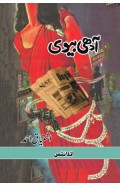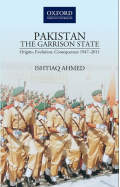- Home
- New & Notable
- Most Sold Non-Fiction
- Pakistan The Garrison State: Origins, Evolution, Consequences (1947-2011)
Pakistan The Garrison State: Origins, Evolution, Consequences (1947-2011)
By: Ishtiaq Ahmad
-
Rs 927.00
- Rs 1,030.00
- 10%
You save Rs 103.00.
Due to constant currency fluctuation, prices are subject to change with or without notice.
external factors to produce the fortress of Islam self-description that became current in the early twenty-first century. Over time, Pakistan succumbed to extremism and terrorism within, and was accused of being involved in similar activities within the South Asian region and beyond. Such developments have been ruinous to Pakistans economic and democratic development. This study explains how and why it happened.
external factors to produce the fortress of Islam self-description that became current in the early twenty-first century. Over time, Pakistan succumbed to extremism and terrorism within, and was accused of being involved in similar activities within the South Asian region and beyond. Such developments have been ruinous to Pakistans economic and democratic development. This study explains how and why it happened.
Badshah Ka Khawab (Qissa Hazrat Yousaf A.S) By Ishtiaq Ahmed
By: Ishtiaq Ahmad
Rs 240.00 Ex Tax :Rs 240.00
Jinnah: His Successes, Failures and Role in History
By: Ishtiaq Ahmad
Rs 4,495.00 Ex Tax :Rs 4,495.00
Pakistan The Garrison State: Origins, Evolution, Consequences (1947-2011)
By: Ishtiaq Ahmad
Rs 927.00 Rs 1,030.00 Ex Tax :Rs 927.00
Zubin Mehta: A Musical Journey (An Authorized Biography)
By: VOID - Bakhtiar K. Dadabhoy
Rs 840.00 Rs 1,050.00 Ex Tax :Rs 840.00
Pakistan: Statecraft and Geopolitics in Todays World
By: Shahid Javed Burki
Rs 1,450.00 Ex Tax :Rs 1,450.00
Jinnah: His Successes, Failures and Role in History
By: Ishtiaq Ahmad
Rs 4,495.00 Ex Tax :Rs 4,495.00
PAKISTAN UNDER BENAZIR BHUTTO 1988-1990 TRIAL OF DEMOCRACY - 1
By: Najam Sethi
Rs 1,596.00 Rs 1,995.00 Ex Tax :Rs 1,596.00
The Origins of Political Order From Prehuman Times to the French RevolutioN
By: Francis Fukuyama
Rs 4,495.00 Ex Tax :Rs 4,495.00
Manning Up: How the Rise of Women Has Turned Men into Boys
By: Kay Hymowitz
Rs 995.00 Ex Tax :Rs 995.00
The Obama Syndrome: Surrender At Home War Abroad
By: Tariq Ali
Rs 1,036.00 Rs 1,295.00 Ex Tax :Rs 1,036.00
The Quest For Meaning: Developing A Philosophy Of Pluralism
By: Tariq Ramadan
Rs 1,116.00 Rs 1,395.00 Ex Tax :Rs 1,116.00
The Pakistan US Conundrum Jihadists The Military And The People The Struggle For Control
By: Yunas Samad
Rs 1,116.00 Rs 1,395.00 Ex Tax :Rs 1,116.00
An Enemy We Created: The Myth Of The Taliban Al Qaeda Merger In Afghanistan 19702010
By: Alex Strick van Linschoten
Rs 4,200.00 Rs 5,250.00 Ex Tax :Rs 4,200.00
WikiLeaks: Inside Julian Assanges War on Secrecy
By: David Leigh & Luke Harding
Rs 850.00 Ex Tax :Rs 850.00
Pakistan: Statecraft and Geopolitics in Todays World
By: Shahid Javed Burki
Rs 1,450.00 Ex Tax :Rs 1,450.00
Jinnah: His Successes, Failures and Role in History
By: Ishtiaq Ahmad
Rs 4,495.00 Ex Tax :Rs 4,495.00
PAKISTAN UNDER BENAZIR BHUTTO 1988-1990 TRIAL OF DEMOCRACY - 1
By: Najam Sethi
Rs 1,596.00 Rs 1,995.00 Ex Tax :Rs 1,596.00
No recently viewed books available at the moment.
Zubin Mehta: A Musical Journey (An Authorized Biography)
By: VOID - Bakhtiar K. Dadabhoy
Rs 840.00 Rs 1,050.00 Ex Tax :Rs 840.00
Badshah Ka Khawab (Qissa Hazrat Yousaf A.S) By Ishtiaq Ahmed
By: Ishtiaq Ahmad
Rs 240.00 Ex Tax :Rs 240.00
Jinnah: His Successes, Failures and Role in History
By: Ishtiaq Ahmad
Rs 4,495.00 Ex Tax :Rs 4,495.00
Pakistan The Garrison State: Origins, Evolution, Consequences (1947-2011)
By: Ishtiaq Ahmad
Rs 927.00 Rs 1,030.00 Ex Tax :Rs 927.00
Pakistan: Statecraft and Geopolitics in Todays World
By: Shahid Javed Burki
Rs 1,450.00 Ex Tax :Rs 1,450.00
Jinnah: His Successes, Failures and Role in History
By: Ishtiaq Ahmad
Rs 4,495.00 Ex Tax :Rs 4,495.00
PAKISTAN UNDER BENAZIR BHUTTO 1988-1990 TRIAL OF DEMOCRACY - 1
By: Najam Sethi
Rs 1,596.00 Rs 1,995.00 Ex Tax :Rs 1,596.00













-By-Ishtiaq-Ahmed-120x187.jpg?q6)






-120x187.jpg?q6)









-120x187.jpg?q6)



-120x187.jpg?q6)



